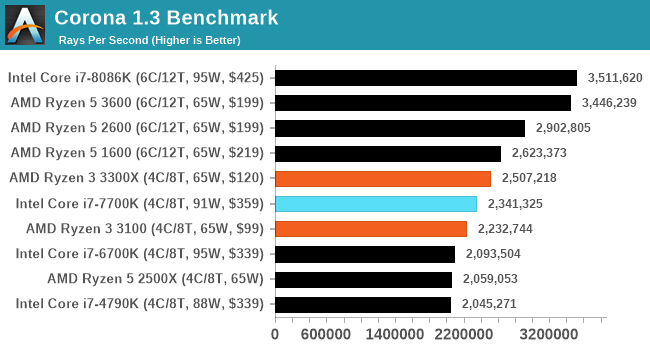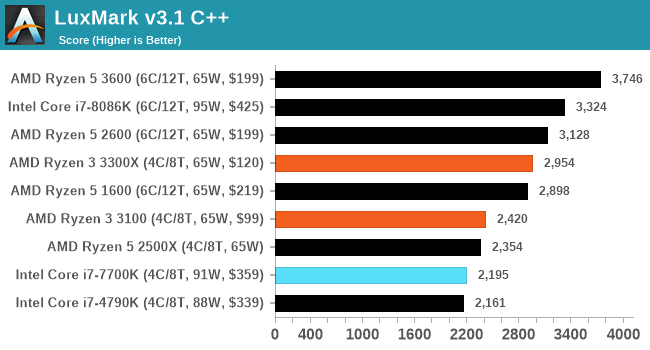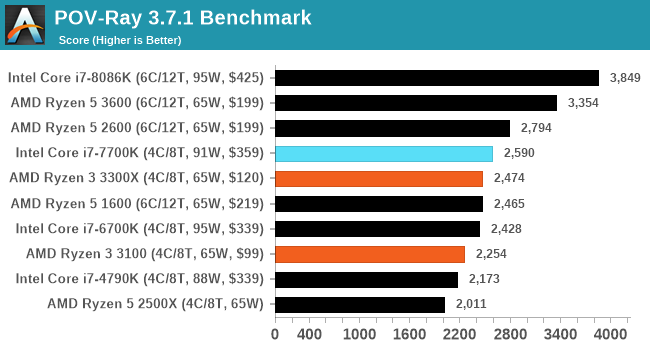The AMD Ryzen 3 3300X and 3100 CPU Review: A Budget Gaming Bonanza
by Dr. Ian Cutress on May 7, 2020 9:00 AM ESTCPU Performance: Rendering Tests
Rendering is often a key target for processor workloads, lending itself to a professional environment. It comes in different formats as well, from 3D rendering through rasterization, such as games, or by ray tracing, and invokes the ability of the software to manage meshes, textures, collisions, aliasing, physics (in animations), and discarding unnecessary work. Most renderers offer CPU code paths, while a few use GPUs and select environments use FPGAs or dedicated ASICs. For big studios however, CPUs are still the hardware of choice.
All of our benchmark results can also be found in our benchmark engine, Bench.
Corona 1.3: Performance Render
An advanced performance based renderer for software such as 3ds Max and Cinema 4D, the Corona benchmark renders a generated scene as a standard under its 1.3 software version. Normally the GUI implementation of the benchmark shows the scene being built, and allows the user to upload the result as a ‘time to complete’.
We got in contact with the developer who gave us a command line version of the benchmark that does a direct output of results. Rather than reporting time, we report the average number of rays per second across six runs, as the performance scaling of a result per unit time is typically visually easier to understand.
The Corona benchmark website can be found at https://corona-renderer.com/benchmark

LuxMark v3.1: LuxRender via Different Code Paths
As stated at the top, there are many different ways to process rendering data: CPU, GPU, Accelerator, and others. On top of that, there are many frameworks and APIs in which to program, depending on how the software will be used. LuxMark, a benchmark developed using the LuxRender engine, offers several different scenes and APIs.
In our test, we run the simple ‘Ball’ scene on both the C++ and OpenCL code paths, but in CPU mode. This scene starts with a rough render and slowly improves the quality over two minutes, giving a final result in what is essentially an average ‘kilorays per second’.

POV-Ray 3.7.1: Ray Tracing
The Persistence of Vision ray tracing engine is another well-known benchmarking tool, which was in a state of relative hibernation until AMD released its Zen processors, to which suddenly both Intel and AMD were submitting code to the main branch of the open source project. For our test, we use the built-in benchmark for all-cores, called from the command line.
POV-Ray can be downloaded from http://www.povray.org/












249 Comments
View All Comments
Spunjji - Monday, May 11, 2020 - link
The issue is that it's not informed. It's codswallop.PeterCollier - Monday, May 11, 2020 - link
You're talking about the article.Spunjji - Tuesday, May 12, 2020 - link
🤡psychobriggsy - Thursday, May 7, 2020 - link
Considering it shows the $120 AMD offering comprehensively beating the old i7-7700K, and says the current Intel budget offerings will be slower, and recommends the AMD processors, I find this comment rather brain dead.WaltC - Thursday, May 7, 2020 - link
One question I had is why AT chose to use the 2600 instead of the 3600...? Makes no sense to me, as the 3600 runs at 65W and the 3600X runs at 95W--just like the 2600--only the 3600 is appreciably faster--but costs the same! 3600 is MIA. No question but that the review benchmarks clearly demonstrate the superiority of the AMD offerings, but we already knew that. I see the omission here--deliberate--of the 3600--while including $425 Intel 6c/12t offerings--as surely an apology for Intel's inability to compete. Such is not needed, really. Apologizing in subtle ways for Intel is, I think, a pretty poor way to write a review on CPUs Intel cannot at the present time compete with--the 3100/3300. Getting right down to it--there was no need to include *any* 6c/12t CPUs here, right? Should have been comparisons only with Intel/AMD 4c/8t cpus, exclusively, imo. Selection of CPUS for *this review* didn't make any objective sense that I could see--beyond the obvious, of course (at least you didn't forget and leave the 3100/3300 out...;))evilspoons - Thursday, May 7, 2020 - link
I'm guessing the omission of the 3600X has something to do with, at the time I read this, they hadn't even finished all the benchmarks for the 3100. You know, the one in the headline. I don't think it's a conspiracy, just a time constraint.crimson117 - Thursday, May 7, 2020 - link
They didn't rerun the 2600 for this, they used existing benchmarks.They haven't ever benchmarked the 3600 previously, so it's not listed here. They do have the 3700X, however, which is essentially the same performance as a 3600 (except in heavily threaded workloads): https://www.anandtech.com/bench/product/2520?vs=25...
MDD1963 - Thursday, May 7, 2020 - link
I saw other testers on Youtube use the 3600, and, the 3300X was VERY surprisingly close to it's performance...; the 3300X's clearly quite strong threads and lack of inter -CCX -RAM latency issues are reaping benefits!BenSkywalker - Thursday, May 7, 2020 - link
The choices they use to compare are utterly bizarre. A three and a half year old Intel i7 and last generation Ryzen parts....?Legitimately, this review is useless if you are shopping *today*, not just from a team red versus team blue, but where this processor sits in today's market, no clue after reading this. One of my friends was looking for a budget gaming build and I was looking at a 3200G/B450 setup, how does this compare? Instead let's assume people have a time machine and are cross shopping two gen old Ryzen and three green old Intel parts....?
The charts aren't bad, they are terrible. Have an old i7 in there for reference, ok, put current Ryzen 3 and i3 inn there and if you don't have enough time *only* include them.
rabidpeach - Friday, May 8, 2020 - link
bro, they try to make a point with the reviews. if you want this comparison you use the cpubench feature of this website and compare any chip they tested on any of the tests they have. it's an actual feature not a bug. the point of this article and tests is to show entry level amd 100 price point is as powerful as 3 year old flagship-ish intel for the mainstream. it shows against the zen and zen+ hexacores that it catches up to them in many situations despite lacking in cores. this shows you amd is not just throwing cores at intel anymore. they have ipc too! ok any more spoon-feeding? would you prefer a spork?